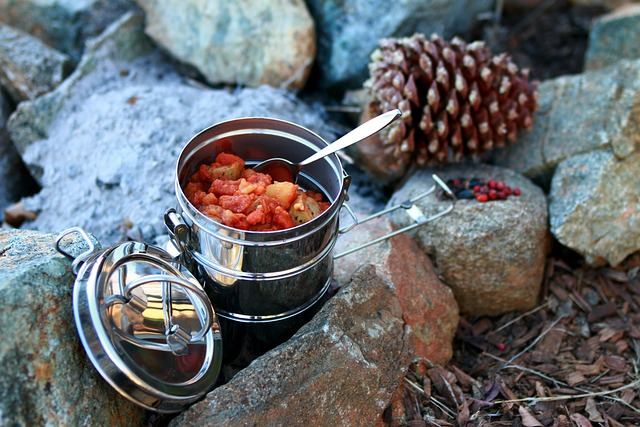I’m no stranger to the joys of camping and the deep satisfaction that comes from savoring a hot and hearty meal in the great outdoors. But, as any seasoned camper knows, keeping your food warm while camping can be a bit of a challenge. The weather can be unpredictable, and campfires don’t always cooperate the way we want them to. So, how to keep food warm while camping?
To keep food warm while camping, consider using insulated food containers like thermoses or vacuum flasks. These containers are excellent at retaining heat for extended periods. Another option is to wrap your hot food in aluminum foil and then insulate it with towels or thermal blankets. Preheating your containers with boiling water before adding food can also help maintain temperature. For campfire cooking, opt for one-pot meals or dishes that can be reheated easily to save time and effort. Finally, remember to consume your meals as soon as they’re ready to ensure they stay warm and safe to eat.
In this article, I’ll share my tried-and-true methods and insider tips on how to keep your food warm, delicious, and safe during your camping adventures. Keep reading!
Why Keeping Food Warm Matters
Before I dive into the nitty-gritty of keeping your food warm while camping, let’s take a moment to understand why it’s such a crucial aspect of your outdoor dining experience.
- Food Safety and Hygiene: First and foremost, keeping your food warm is a matter of safety. Bacteria multiply rapidly in food that’s left at temperatures between 40°F (4°C) and 140°F (60°C). When you’re camping, proper food safety becomes even more critical because you may not have access to refrigeration. Eating cold or lukewarm food that’s been sitting out for too long can lead to foodborne illnesses, and trust me, that’s not the kind of adventure you want on your camping trip.
- Satisfaction of a Hot Meal: There’s a unique comfort that comes from enjoying a hot meal, especially when you’re out in the wild. A warm dish not only nourishes your body but also warms your spirit. It’s a reward for your outdoor efforts and a reminder of the creature comforts of home.
- Avoiding Disappointment: Imagine preparing a mouthwatering camping recipe, investing time and effort into cooking it, only to have it turn cold and unappetizing by the time you’re ready to eat. Keeping your food warm ensures that all your culinary creations are enjoyed as they were meant to be, preventing the disappointment of a lackluster meal.
Keeping food warm while camping, it’s not just about convenience—it’s about safety, satisfaction, and savoring the full camping experience.
Essential Tools and Equipment
Now that I’ve established why it’s crucial to keep your food warm while camping, it’s time to explore the essential tools and equipment that will help you achieve this culinary feat. Whether you’re a camping newbie or a seasoned outdoor chef, having the right gear can make all the difference in your campfire cooking adventures.
Let’s dive into the must-have tools and equipment for keeping your camping meals warm and delicious:
A. Insulated Food Containers: Keeping Warmth Locked In
- Types and Features to Consider: Insulated food containers come in various shapes and sizes, from thermoses to lunch boxes. Look for containers with double-wall insulation and secure, airtight lids. Some even come with built-in compartments for keeping different parts of your meal separate until you’re ready to eat.
- Brands and Models Worth Exploring: Popular brands like Yeti, Hydro Flask, and Stanley offers a wide range of insulated food containers that are known for their durability and heat retention capabilities. Be sure to read reviews and choose one that suits your needs.
B. Portable Stoves and Grills: Cooking on the Go
- Fuel Options and Setup Tips: Portable stoves can run on various fuels, including propane, butane, and even wood. Choose a stove that aligns with your cooking style and the availability of fuel sources at your campsite. Ensure your stove is set up on a stable, level surface away from flammable materials.
- Cooking Utensils and Cookware Recommendations: Don’t forget to pack camping pots and pans, utensils, and heat-resistant gloves. Look for lightweight, compact options that fit your stove and cooking needs. Cast iron skillets and Dutch ovens are great for campfire cooking and heat retention.
C. Thermoses and Thermal Bags: Keeping Liquids and Soups Hot
- How They Work and When to Use Them: Thermoses are perfect for keeping hot beverages like coffee, tea, or hot chocolate warm throughout the day. Thermal bags, on the other hand, are designed to maintain the temperature of cooked dishes such as soups, stews, or chili. Use them to transport your hot meals from the campfire to the picnic table.
- Selecting the Right Size and Type: Choose a thermos with a capacity that matches your beverage consumption. Insulated thermal bags come in various sizes, so consider the number of servings you need to keep warm. Look for bags with sturdy zippers and insulation that can maintain heat for hours.
Armed with these essential tools and equipment, you’ll be well-prepared to tackle the challenge of keeping your camping meals warm. In the next sections, I’ll delve deeper into the specifics of campfire cooking techniques and meal preparation, so you can enjoy piping hot, delicious dishes in the heart of the wilderness.
Preparing Your Meals for Warmth
Now that I’ve covered the essential tools and equipment, let’s shift our focus to the heart of the matter: preparing your meals in a way that ensures they stay warm and delicious from the campfire to your plate. Here are some key considerations and strategies for meal preparation:
A. Choosing the Right Recipes: Campfire-Friendly Dishes
- Simplicity is Key: When planning your camping menu, opt for recipes that are relatively simple to prepare and cook. Camping is about relaxation and enjoying the outdoors, so choose dishes that won’t require hours of prep work or intricate cooking techniques.
- One-Pot Meals: One-pot meals are a camper’s best friend. These dishes, like chili, stew, or stir-fry, allow you to cook everything in a single pot or pan, minimizing the number of containers you need to keep warm and wash.
B. Pre-cooking and Reheating Strategies: Safe and Flavorful
- Safe Handling and Storage: Before you hit the trail, pre-cook certain components of your meals at home. For example, you can marinate meat, par-cook pasta, or chop vegetables in advance. Ensure that these ingredients are stored in airtight containers or sealed bags to prevent contamination.
- Tips for Reheating Without Compromising Flavor: When it’s time to eat, reheating is your friend. Reheat dishes gradually to avoid scorching or overcooking. Use a lower flame or indirect heat on your stove or campfire. For foil packet meals, place them near the edge of the fire, not directly in the flames.
By selecting recipes that are easy to prepare and implementing pre-cooking and reheating strategies, you can streamline your camping cooking process and ensure your meals stay warm without sacrificing taste or safety.
Campfire Cooking Techniques
Now, let’s explore the exciting world of campfire cooking techniques. Mastering these methods will allow you to whip up mouthwatering meals that stay warm and satisfying in the great outdoors. Here are three essential campfire cooking techniques to add to your culinary arsenal:
A. Building and Maintaining a Campfire
- Safety Precautions: Before you start cooking, prioritize safety. Choose a designated cooking area away from your tent and other flammable materials. Clear the area of dry leaves and twigs. Keep a bucket of water or a fire extinguisher nearby for emergencies.
- Controlling Heat for Cooking: The key to successful campfire cooking is controlling the heat. You can adjust the heat by adding or reducing the number of logs or coals under your cooking area. A hot fire with flames is ideal for boiling water, while a bed of hot coals provides steady, even heat for grilling and Dutch oven cooking.
B. Dutch Oven Cooking
- Recipes and Step-by-Step Instructions: Dutch ovens are versatile tools for campfire cooking. You can use them to bake, simmer, or roast a wide variety of dishes. Some classic Dutch oven recipes include campfire chili, cornbread, and cobblers. Follow specific recipes and cooking times for best results.
- Seasoning and Cleaning Tips: Cast iron Dutch ovens require special care. Before your camping trip, season your Dutch oven by coating it with oil and heating it until it develops a non-stick surface. After cooking, clean the Dutch oven by scraping off food residue, rinsing with hot water (no soap), and drying thoroughly. Re-season as needed to maintain its non-stick properties.
C. Foil Packet Cooking
- Ingredients and Flavor Combinations: Foil packet cooking is a camper’s dream. Wrap ingredients in aluminum foil and cook them directly on the campfire coals. The possibilities are endless, from savory chicken and vegetable packets to sweet dessert packets with apples and cinnamon. Experiment with different ingredients and seasonings to suit your taste.
- Cooking Times and Methods: The cooking time for foil packets varies based on the ingredients and packet size. Remember that foods like potatoes and root vegetables take longer to cook than thinly sliced meat or fish. To check for doneness, carefully open a packet and use a fork to test the tenderness of the ingredients.
Let’s explore insulation and heat retention techniques to ensure that your culinary creations stay warm until it’s time to dig in.
Insulation and Heat Retention
Now that you’ve got your campfire cooking techniques down pat, let’s turn our attention to the crucial topic of insulation and heat retention. These techniques will help you keep your meals warm and ready to enjoy, even after they’ve left the heat of the fire. Here’s how to make sure your campfire creations stay piping hot:
A. Wrapping and Packing Food: Heat-Locking Techniques
- Using Aluminum Foil: Aluminum foil is your best friend when it comes to insulating and retaining heat for your food. After cooking your meal on the campfire or stove, wrap it tightly in multiple layers of aluminum foil. Be sure to seal the edges to keep the heat in.
- Thermal Blankets: If you have thermal blankets on hand, wrap your foil-wrapped food parcels in them. These blankets are designed to retain heat and are especially useful for keeping dishes warm during transportation from the fire to your campsite.
- Creating Insulation Layers in Your Cooler: If you have access to a cooler, use it wisely. Place your foil-wrapped meals inside the cooler and layer them with towels or extra clothing to create insulation. This extra layer of insulation helps maintain the warmth of your food for an extended period.
B. DIY Heat Retention Hacks: Keeping Warmth Intact
- Hot Water Bottles: Fill heat-resistant bottles with hot water and place them inside your cooler or around your foil-wrapped food. These hot water bottles act as heat sources, helping to keep the entire cooler warm.
- Heated Rocks: If you’re in an area with accessible rocks, heat them in or near the campfire. Once they’re hot, wrap them in towels or aluminum foil and place them strategically in your cooler or around your food containers. These heated rocks can maintain warmth for hours.
- Layering Techniques: When it comes to foil packet cooking, consider layering your ingredients strategically. Place ingredients that take longer to cook, like potatoes, at the bottom of the packet, and add quicker-cooking items, like fish or thinly sliced meat, on top. This way, the heat will rise and evenly cook the entire packet.
By implementing these insulation and heat retention techniques, you can ensure that your campfire-cooked meals stay warm and ready to enjoy. Whether you’re sitting by the campfire, exploring the wilderness, or settling into your campsite after a day of adventure, you’ll have hot and satisfying food waiting for you.
Campfire-Friendly Side Dishes
While the main course often steals the spotlight, don’t underestimate the power of delicious side dishes to elevate your camping meals. These campfire-friendly sides are not only easy to prepare but also add a burst of flavor and variety to your outdoor dining experience. Here are some mouthwatering options to consider:
A. Campfire Bread and Biscuits: Warm and Crispy
- Campfire Skillet Cornbread: Prepare a simple cornbread batter at home and cook it in a cast iron skillet over the campfire. The result? Golden, crispy, and oh-so-satisfying cornbread to complement your main course.
- Grilled Flatbreads: Bring pre-made pizza dough or flatbread dough (homemade or store-bought) and roll it out. Cook it directly on the campfire grate for a smoky and delicious flatbread to enjoy with dips, spreads, or as a side.
B. Grilled Vegetables and Foil Packet Recipes: Nature’s Bounty
- Grilled Vegetables: Slice up a colorful assortment of bell peppers, zucchini, onions, and mushrooms. Season them with olive oil, salt, pepper, and your favorite herbs. Grill them in a foil packet or on a grate until they’re tender and lightly charred.
- Foil Packet Potatoes: Create foil packets filled with diced potatoes, garlic, onions, and a drizzle of olive oil. Add your preferred seasonings and herbs. Cook the packets over the campfire until the potatoes are tender and infused with flavor.
- Roasted Corn on the Cob: Soak whole ears of corn in water for about 30 minutes. Wrap them in aluminum foil with a pat of butter and your choice of seasonings. Place them on the campfire grate and rotate occasionally until the corn is tender and slightly charred.
C. Easy-to-Make Dips and Spreads: Flavor Explosion
- Campfire Queso Dip: Bring a cast iron skillet and cook up a gooey, cheesy queso dip over the campfire. Add diced tomatoes, green chilies, and your favorite spices for an extra kick. Serve with tortilla chips for dipping.
- Hummus and Veggie Platter: Pack some store-bought or homemade hummus and a selection of fresh vegetables like carrot sticks, cucumber slices, and bell pepper strips. This makes for a healthy and satisfying campfire snack or side dish.
These campfire-friendly side dishes are not only easy to prepare but also enhance your camping meals with a burst of flavor and variety.
Safety Considerations
While camping and enjoying delicious meals in the great outdoors is a delightful experience, it’s essential to prioritize safety to ensure your culinary adventures remain enjoyable and free from health hazards. Here are some critical safety considerations to keep in mind:
A. Preventing Foodborne Illnesses
- Safe Temperature Zones: Pay close attention to food temperatures. Keep cold foods below 40°F (4°C) and hot foods above 140°F (60°C). Use a food thermometer to check the temperature of cooked dishes to ensure they remain in the safe range.
- Food Handling Hygiene: Maintain good hygiene practices when handling food. Wash your hands thoroughly with soap and water before and after handling food. Use hand sanitizer if clean water is not readily available.
- Proper Storage: Store raw meats and seafood separately from ready-to-eat foods in sealed containers to prevent cross-contamination. Use a portable cooler with ice packs to keep perishable items cold.
B. Fire Safety and Precautions
- Campfire Safety Guidelines: Follow established campfire safety rules, such as keeping fires small and manageable. Clear a safe area around your campfire, away from flammable materials like dry grass, leaves, and tents.
- Stove Safety Tips: If you’re using a portable stove, ensure it’s placed on a stable, level surface, and never leave it unattended while in use. Keep flammable materials away from the stove’s open flame.
C. Proper Disposal of Ashes and Coals
- Safe Ash Disposal: Allow ashes and coals from your campfire or stove to cool completely before disposing of them in a designated fire pit or container. Hot ashes can cause fires if not handled carefully.
D. Cleaning Cookware and Utensils
- Cleaning with Biodegradable Soap: When cleaning cookware and utensils, use biodegradable soap and hot water to minimize environmental impact. Avoid using regular dish soap in natural water sources to protect aquatic ecosystems.
- Leave No Trace: Follow the “Leave No Trace” principles by cleaning up after yourself. Collect food scraps and trash, and pack them out in a sealed container. Leave your campsite as you found it.
Cleaning Up and Leaving No Trace
Camping isn’t just about enjoying the great outdoors; it’s also about respecting and preserving the environment. To leave a positive impact and minimize your footprint, it’s crucial to clean up after yourself and adhere to the principles of “Leave No Trace.” Here’s how you can do your part:
A. Proper Disposal of Ashes and Coals
- Safe Ash and Coal Disposal: Allow ashes and coals from your campfire or stove to cool completely. Use a designated fire pit or container for ash disposal if available at your campsite. Never scatter hot ashes or coals in the wilderness, as they can pose a fire hazard.
B. Cleaning Cookware and Utensils
- Use Biodegradable Soap: When washing your cookware, utensils, and dishes, use biodegradable soap and hot water. Biodegradable soap minimizes the environmental impact. Be sure to rinse your cookware thoroughly to remove all traces of soap.
- Avoid Using Regular Dish Soap in Natural Water Sources: Refrain from using regular dish soap in rivers, lakes, or streams. The chemicals in conventional soap can harm aquatic ecosystems. Instead, use a basin or bucket to collect and dispose of your wastewater away from natural water sources.
C. Leave No Trace Principles
- Plan Ahead and Prepare: Plan your meals and cooking methods to minimize waste and environmental impact. Pack reusable containers, utensils, and dishware to reduce disposable items.
- Dispose of Waste Properly: Collect all food scraps, trash, and litter in sealed bags or containers. Carry out all your trash and dispose of it in designated receptacles or at a proper disposal site. Never leave trash or food scraps behind.
- Respect Wildlife: Store food securely to prevent wildlife encounters. Feeding wildlife is harmful to their health and disrupts their natural behaviors. Keep a safe distance and observe wildlife without approaching or feeding them.
- Stay on Established Trails and Campsites: Stick to established trails and camp in designated areas to minimize your impact on fragile ecosystems. Avoid creating new trails or disturbing vegetation.
- Leave What You Find: Don’t pick plants, disturb rocks, or remove natural objects from the environment. Leave natural and cultural features as you found them to preserve their beauty and significance.
- Minimize Campfire Impact: Use a camp stove for cooking instead of making a fire, especially in areas with fire restrictions. If fires are allowed, use established fire rings or fire pans. Burn only small sticks and twigs, and keep fires small and manageable.
- Respect Other Campers: Maintain quiet hours, keep noise levels down, and be considerate of other campers. Respect their privacy and the tranquility of the wilderness.
Leaving no trace is not just a responsibility; it’s a commitment to protecting the environment and fostering a culture of responsible outdoor recreation.
Conclusion
The importance of keeping food warm while camping cannot be overstated. It’s not only about satisfying your taste buds but also about nourishing your body and soul. As you bask in the natural beauty of the wilderness, there’s something truly magical about indulging in a hot, hearty meal by the campfire. Whether you’re surrounded by friends and family, forging new connections, or seeking solitude, warm meals in the great outdoors foster a sense of unity with nature and provide moments of respite and joy.
Now, with safety always at the forefront of your mind and a commitment to preserving the environment through responsible cleanup, you’re not just a camper but a steward of the wilderness. By practicing the principles of “Leave No Trace,” you’re ensuring that the landscapes you explore remain pristine and untouched for generations to come.
So, as you venture into the wilderness, let the aroma of your campfire-cooked meals be a testament to your culinary prowess and your love for the outdoors. Share stories, laughter, and the warmth of your meals with fellow campers, creating lasting memories that will be cherished for years.
Happy camping, and may your outdoor feasts be as warm and delightful as the memories you create along the way.
Here is another great article that you must read: How To Keep Your Food Cold While Camping
Additional Resources
Your journey to becoming a camping culinary expert doesn’t have to end here. There are plenty of resources available to expand your knowledge, discover new recipes, and connect with the camping community. Here are some recommended sources to continue your exploration:
- Camping Cookbooks:
- Online Camping Forums and Communities:
- YouTube Channels and Cooking Blogs:
- Social Media:
- Outdoor Gear Retailers:
- Visit the websites of your local outdoor gear stores, such as REI, Cabela’s, or Bass Pro Shops, for camping cookware and equipment.
- Camping and Outdoor Magazines:
- Cooking Classes and Workshops:
- Search for local cooking workshops or check online platforms like Udemy for outdoor and campfire cooking classes.
- National and State Park Websites:
- Visit the websites of specific national and state parks for information on camping regulations, food storage guidelines, and recommended camping recipes relevant to your camping destination.










